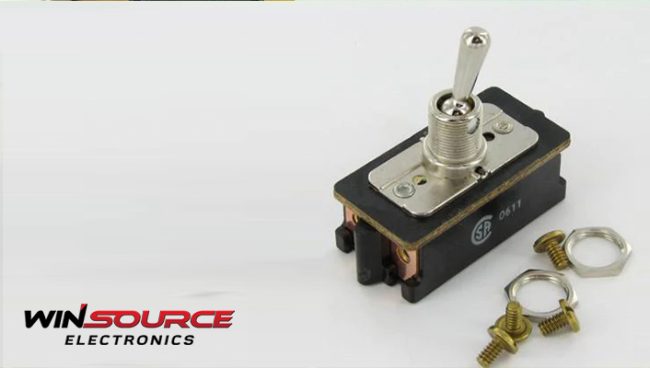
Toggle switches are fundamental components in electronic and electrical systems, serving as on/off or toggleable control mechanisms. Among the many toggle switches available, the EK204-73 is a reliable and versatile choice for various applications.
This technical guide covers the design considerations and implementation tips essential for effectively integrating the EK204-73 toggle switch. So, let’s begin.
Table of Contents
ToggleWhat is the EK204-73 Toggle Switch?
The EK204-73 is a ruggedized toggle switch known for its durability and robust performance. With a compact design and a wide range of configurations, it is suitable for aerospace, automotive, and industrial automation applications. Before delving into the design considerations, it’s crucial to understand the key features of the EK204-73 toggle switch:
Key Features And Specifications of EK204-73 Toggle Switch
Durability: The EK204-73 is designed to withstand harsh environmental conditions, making it ideal for applications where reliability is paramount.
Configurability: This toggle switch comes in various configurations, including single-pole, double-pole, single-throw, and double-throw options, allowing engineers to select the most suitable variant for their specific requirements.
Actuation Force: The actuation force required to toggle the switch is critical to user experience. The EK204-73 is engineered to provide a balanced actuation force, ensuring ease of use while preventing accidental toggling.
Contact Ratings: The switch supports a contact current rating of 20 A, accommodating different voltage and current requirements. It’s essential to choose the appropriate variant based on the specific electrical parameters of the application.
Mechanical Life: With a mechanical life of 100 cycles, the EK204-73 ensures long-lasting performance in demanding operational conditions.
Electrical Life: The switch boasts an electrical life of 25 cycles, indicating its reliability in numerous on-off cycles.
Temperature Range: The EK204-73 operates within a temperature range of -17.8 °C to 65.6 °C, making it suitable for a broad spectrum of environments.
Contact Plating: Nickel contact plating enhances the switch’s corrosion resistance and ensures consistent electrical performance.
Illumination Type: The switch is available in illuminated and non-illuminated variants, catering to applications with diverse visibility requirements.
Max Voltage Rating: With a maximum voltage rating of 250 V AC/DC, the switch can handle various voltage levels.
Termination: The EK204-73 features a screw termination, simplifying the wiring process for integration into electronic systems.
Switch Function: The switch operates in an On-Off configuration, providing a straightforward control mechanism.
Throw Configuration: The switch follows a DPST (Double-Pole, Single-Throw) configuration, offering versatility in electrical connections.
Compact Dimensions: At 54 mm high, 25.4 mm wide, and 12.7 mm in hole diameter, the switch offers a compact form factor for easy integration into panels.
Actuator Length: The actuator length of 17.44 mm provides users a tactile and ergonomic interface.
Design Considerations
1. Environmental Factors:
Temperature Range: Ensure that the selected variant of the EK204-73 is suitable for the application’s operating temperature range. This is crucial for maintaining optimal performance in extreme cold and hot conditions.
IP Rating: Consider the Ingress Protection (IP) rating of the toggle switch to determine its resistance to dust and moisture. For applications in demanding environments, a higher IP rating is recommended.
2. Electrical Compatibility:
Voltage and Current Ratings: Match the switch’s voltage and current ratings with the application’s electrical specifications. Choosing a variant with appropriate contact ratings is vital to prevent overheating and ensure the switch’s longevity.
Circuit Configuration: Based on the electrical circuit requirements, select the right configuration (single-pole, double-pole, single-throw, double-throw). Understanding the circuitry is essential to prevent compatibility issues.
3. Mechanical Integration:
Panel Cutout Dimensions: Confirm that the panel cutout dimensions align with the specifications provided in the EK204-73 datasheet. A precise fit is crucial for seamless panel mounting.
Actuator Style: The switch may offer different actuator styles, such as bat or paddle handles. Choose the style that best suits the application’s ergonomic and functional needs.
4. Safety Considerations:
Locking Mechanism: Consider switches with locking mechanisms in applications where accidental toggling could have severe consequences. This prevents unintended changes in the switch position.
Short Circuit Protection: Incorporate additional circuitry or fuses to protect the switch and the overall system in case of a short circuit.
Implementation Tips
1. Thorough Testing:
Comprehensive testing must be conducted before integrating the EK204-73 into the final system. This includes functional tests to ensure the switch operates as expected and stress tests to evaluate its performance under extreme conditions.
2. Proper Wiring:
Follow the manufacturer’s guidelines for wiring the toggle switch. Ensure secure connections and use appropriate wire gauges to handle the current load.
Furthermore, strain relief measures should be implemented to prevent damage to the wiring due to mechanical stress.
3. Documentation:
Maintain detailed documentation of the switch installation, including wiring diagrams, panel cutout dimensions, and any modifications to accommodate the switch. Also, clear instructions for maintenance and troubleshooting should be provided to streamline future repairs or upgrades.
4. Calibration and Alignment:
If the application requires precise alignment or calibration, ensure the toggle switch is installed and adjusted correctly. This is particularly important in applications where the switch position corresponds to specific settings or modes.
5. Sealing and Insulation:
Apply appropriate sealing materials to protect the switch from environmental elements. This is critical in applications exposed to moisture, dust, or corrosive substances. The switch must also be inspected properly to prevent electrical interference or short circuits caused by environmental factors.
6. User Training:
If the toggle switch is part of a user interface, provide adequate training for end-users. Clearly communicate the switch’s functionality, especially if it has multiple positions or modes. Moreover, intuitive labeling should be incorporated to guide users in operating the switch correctly.
Conclusion
Engineers can ensure the seamless integration of the EK204-73 into their systems by carefully considering environmental factors, electrical compatibility, mechanical integration, and safety considerations.
Moreover, thorough testing, proper wiring, documentation, calibration, sealing, and user training are crucial steps to maximize the toggle switch’s performance and longevity in diverse applications.
WIN SOURCE is a reliable distributor for sourcing toggle switches and related components. It has an extensive inventory of electronic components and is committed to quality.

COMMENTS